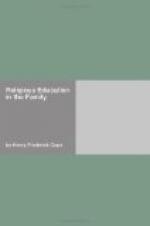A syllabus of each lesson will be helpful, provided it be prepared by the students themselves. Encourage the careful reading of the lesson by every member of the class, letting the syllabus grow out of this.
Notebooks will have their largest value if used at home for two purposes: first, to set down the student’s analysis of the book as he reads, secondly, to record the student’s observations on definite problems and on practice in the home. Note-taking in the class will have very little value unless it is backed up by study at home.
Generalization. Have clearly in your own mind a definite concept of the general principle underlying each section. Read through each section until you can state the principle for yourself. Bring your teaching into a focus at the point of that principle before the lesson ends. Try to get the members of the class to state the principle in their own words.
In action: The principles will have little value unless translated into practical methods; direct your teaching to their actual use in families. Your generalization is for guidance into application. Urge that the plans described be actually tried. Expect this and call for reports on plans tested in the daily experience of families. If a number of students would try, for example, the plan of worship suggested for two or three weeks and report their experiences in writing, together with the accounts of any other plans tried, a valuable budget of helpful knowledge could thus be gathered.[53]
Conference plan: Some classes will be able to meet twice a week, taking the lesson at one session and at another spending the time in conference. At the conference period the program might provide for (1) brief papers by members of the class on topics personally assigned, (2) abstracts or summaries of assigned readings, (3) discussion on the particular points raised in the papers, and (4) conference on unsettled questions from the lesson for the class period preceding.
Club work: A parents’ club might be organized, either in a church or in connection with a school, which would use this textbook, follow the study work with conferences, and would secure for its own use a library of the books listed after each chapter. Such a club would be able to put into practice some of the plans advocated and could encourage their application in groups of families.
FOOTNOTES:
[53] The teachers are especially invited to secure records of actual experiments of this character. Accounts of tried methods of family worship, especially those with new features, which should be given in some detail as to the exact plan, the circumstances, the material used, and the results, should be sent to the author in care of the publishers. Perhaps in this way material which may be valuable to large numbers may be gathered.




